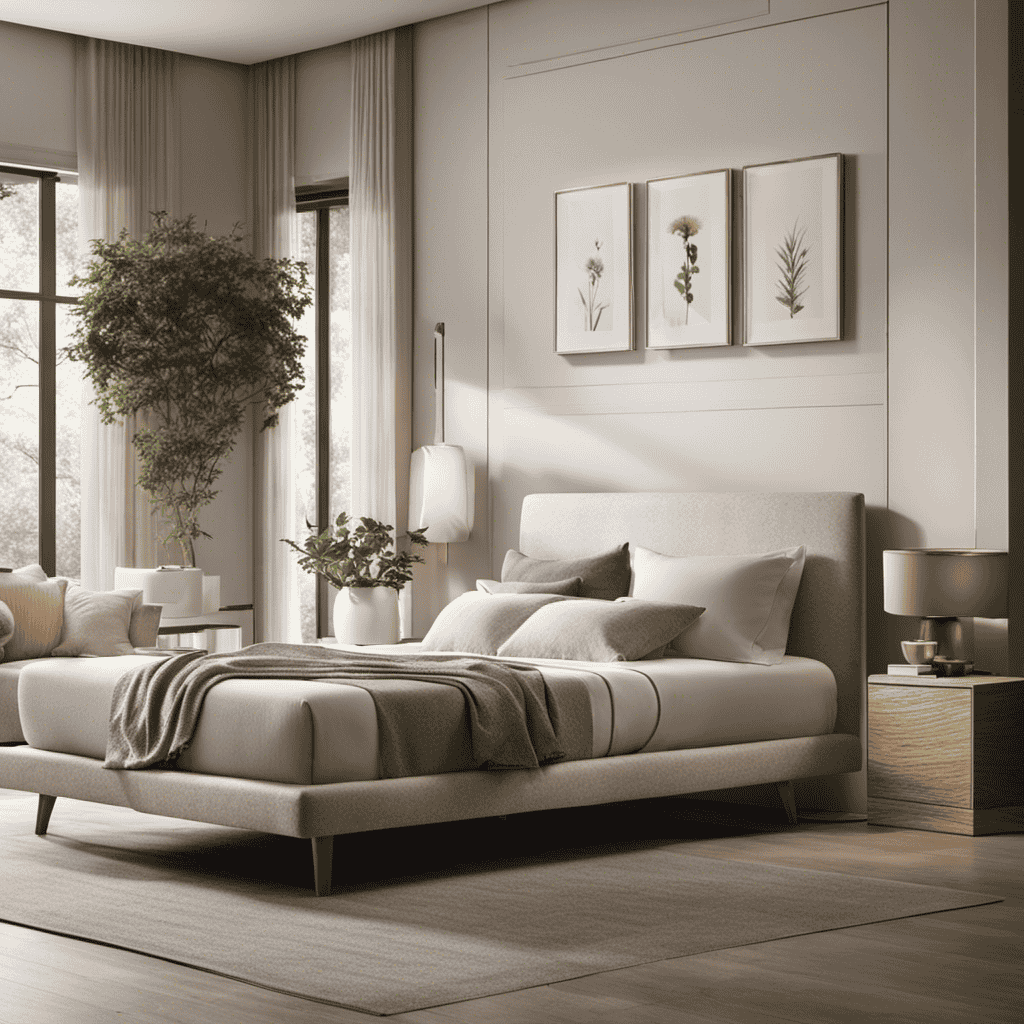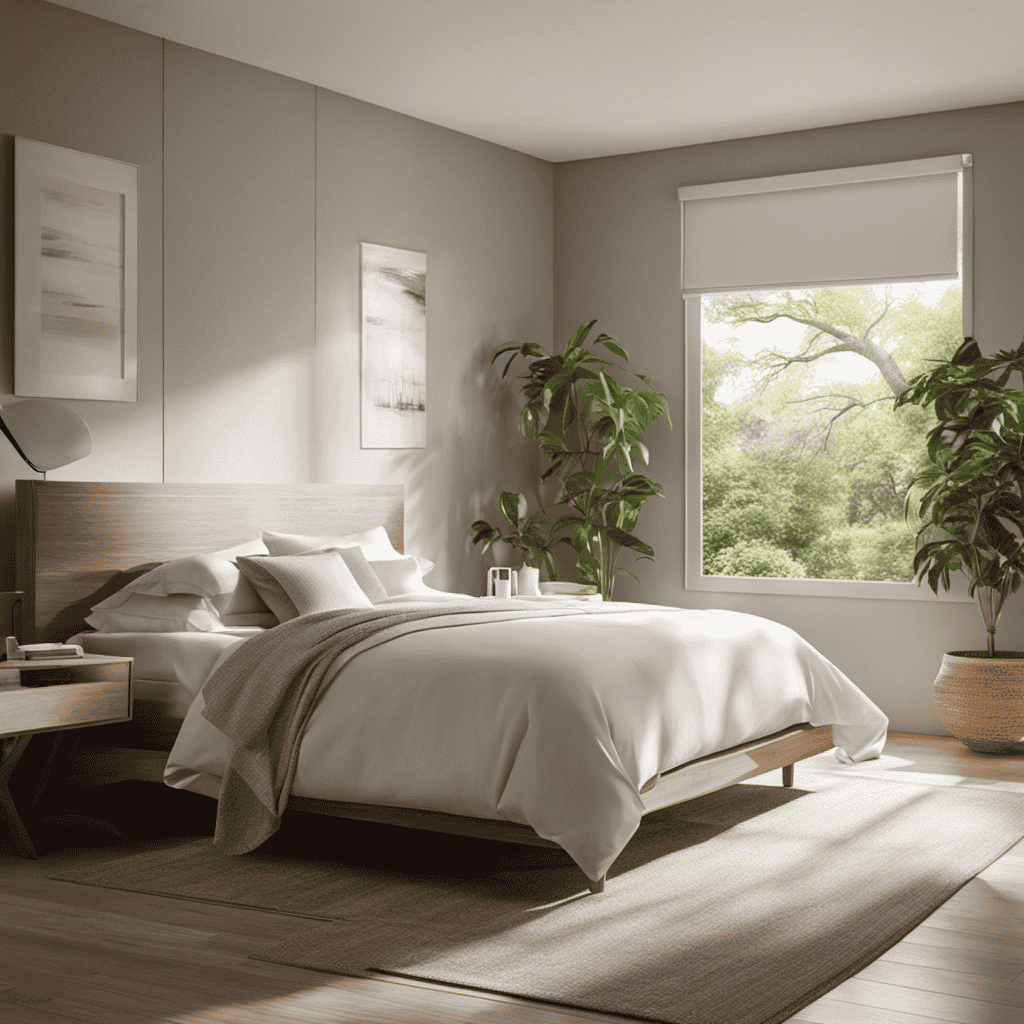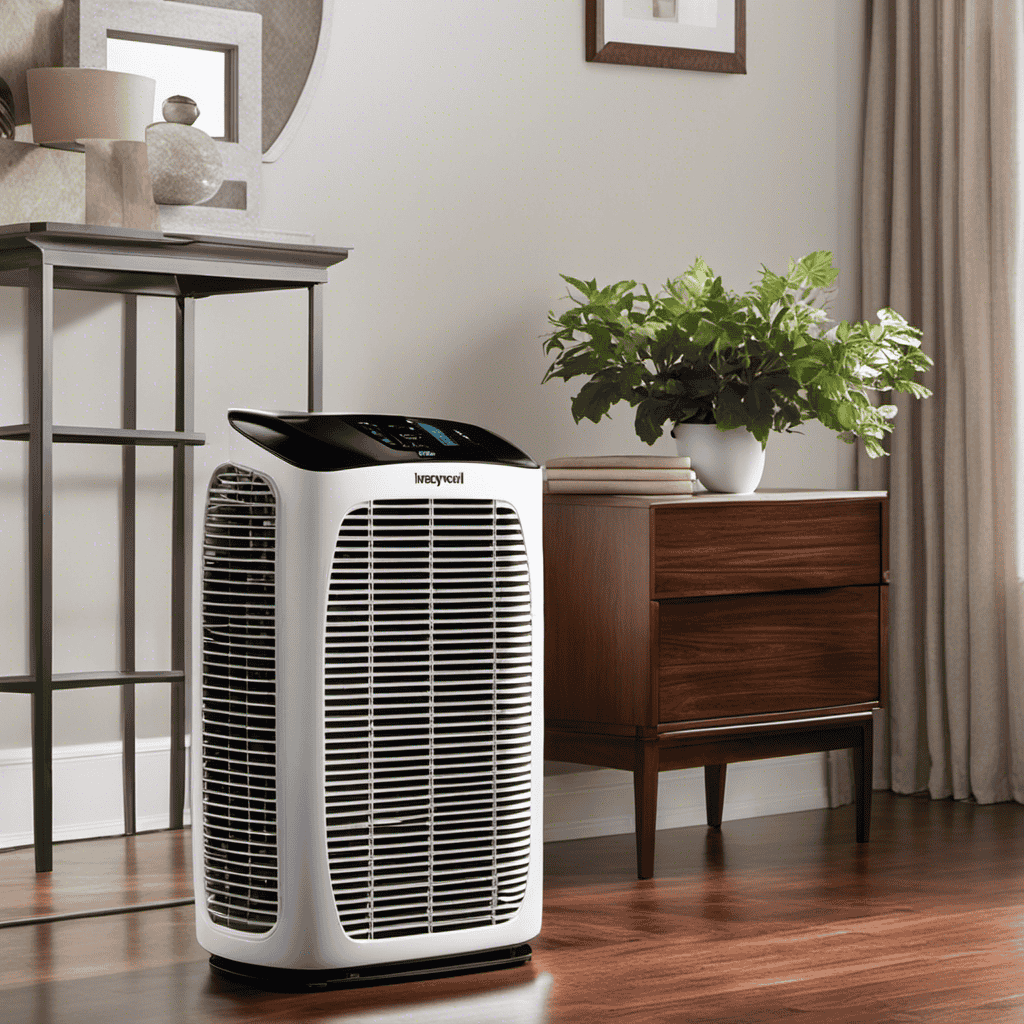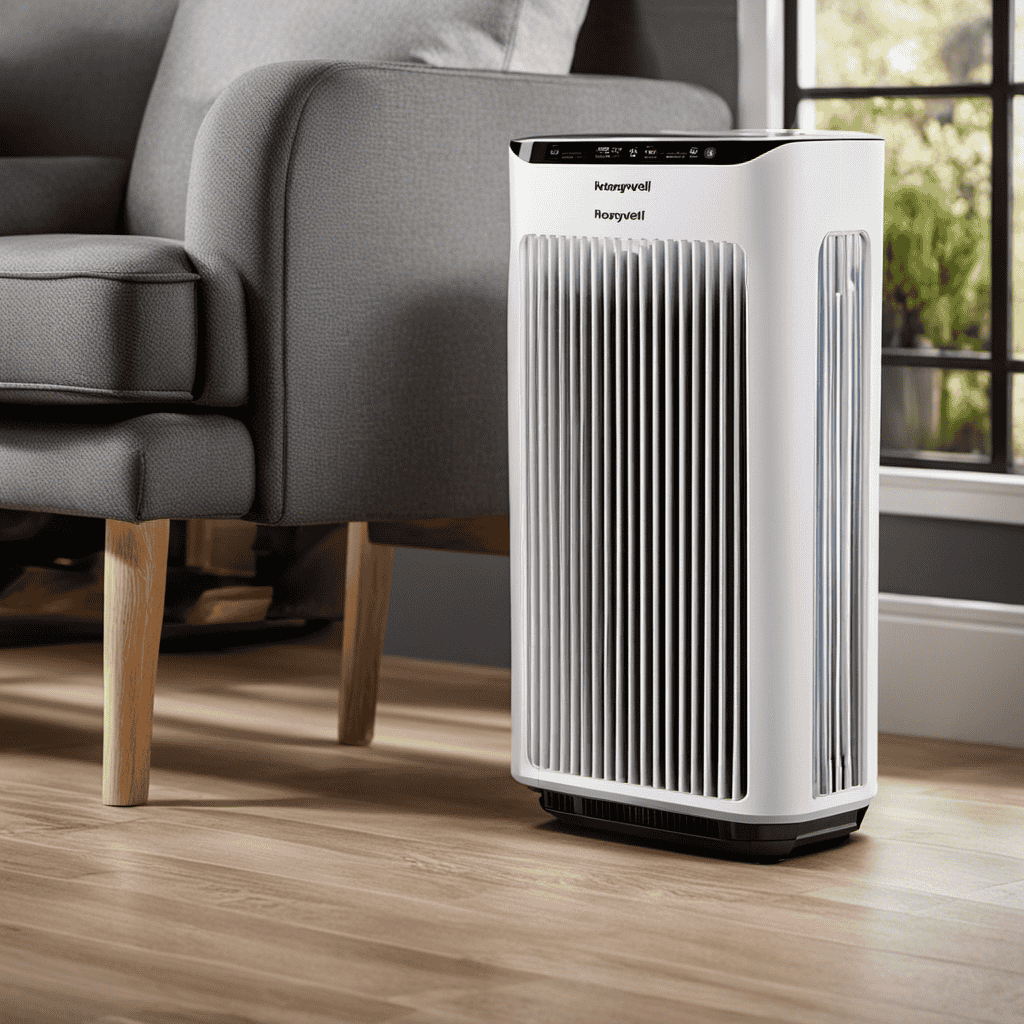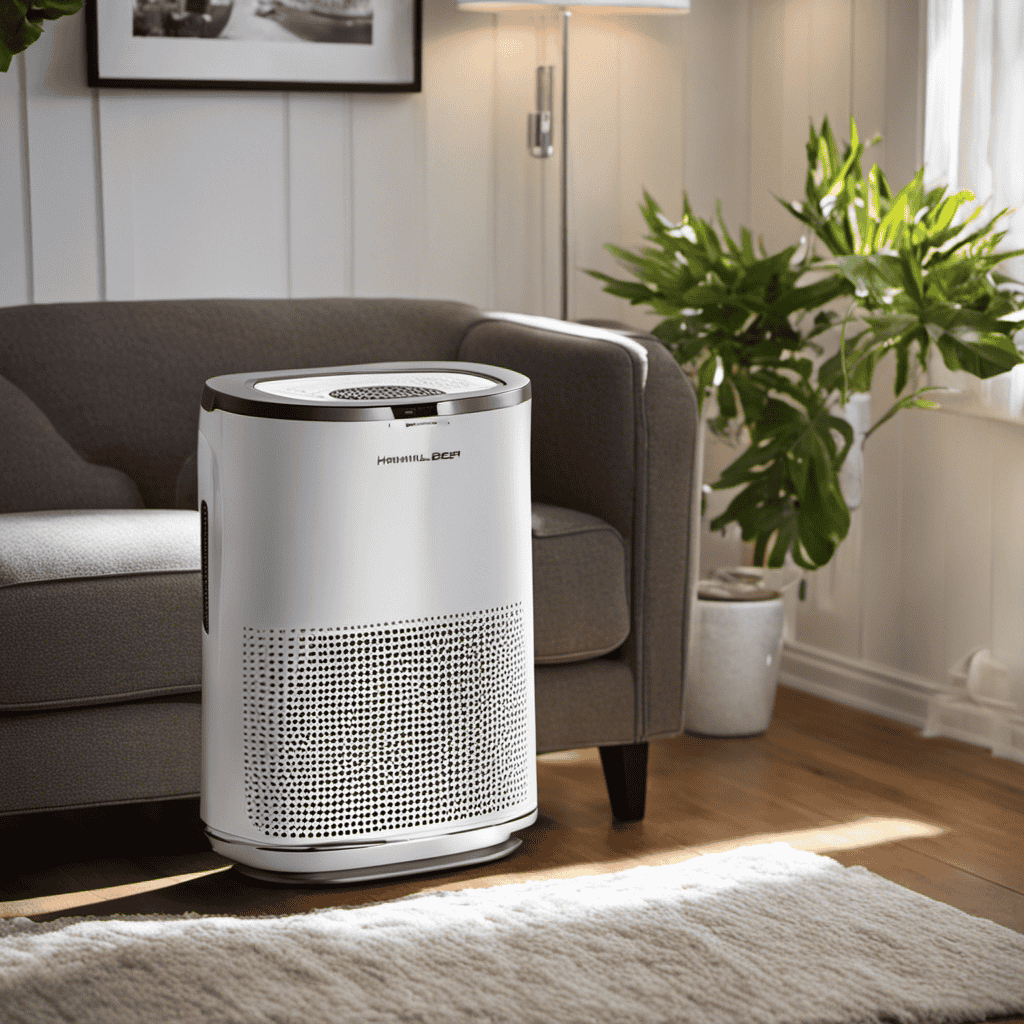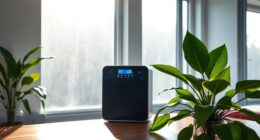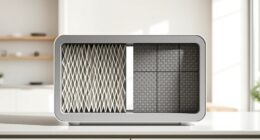I truly believe in the saying, ‘Home is where the heart is.’ For me, my heart truly belongs in a clean and fresh home.
That’s why I’ve turned to the Coway air purifier to keep the air in my living space pure and healthy.
In this article, I’ll guide you through the best places to position your Coway air purifier for maximum effectiveness. From the bedroom to the gym, we’ll explore every area to ensure you’re breathing in nothing but the best.
So let’s dive in and discover the ideal spots for your Coway air purifier.
Key Takeaways
- The Coway Air Purifier should be strategically placed in different rooms for optimal air purification.
- In the living room, the purifier should be placed in an open area away from obstructions, and multiple units may be necessary for proper air purification.
- In the bedroom, the purifier should be placed near the bed within 6 feet and away from walls and furniture for better air circulation and filtration, improving sleep quality and respiratory health.
- In the kitchen, the purifier should be placed to remove smoke particles generated during cooking and reduce unpleasant odors, improving overall air quality in the kitchen.
In the Living Room
You should place the Coway air purifier in your living room where it will help improve the air quality. The living room is often a central space in the house where family members gather and spend a significant amount of time. Therefore, it is vital to ensure that the air in this area is clean and free from pollutants.
The optimal placement of the Coway air purifier in the living room is crucial for its air purification effectiveness. To maximize the air purification effectiveness of the Coway air purifier, it is recommended to place it in an open area within the living room, away from obstructions such as furniture or curtains. This will allow for better air circulation and ensure that the purifier can effectively remove airborne contaminants.
Additionally, it is important to consider the size of your living room when determining the optimal placement of the air purifier. For larger living rooms, it may be necessary to place multiple units to cover the entire area adequately. By strategically placing the purifiers in different locations, you can ensure that all corners of the living room receive proper air purification.
In the Bedroom
When it comes to optimal bedroom purifier placement, there are a few key points to consider.
Firstly, it is recommended to place the purifier near the bed, ideally within 6 feet, to ensure the cleanest air possible during sleep.
Secondly, positioning the purifier away from walls and furniture allows for better air circulation and filtration.
Lastly, the benefits of having a purifier in the bedroom include reducing allergens, dust, and pet dander, which can lead to better sleep quality and overall respiratory health.
Optimal Bedroom Purifier Placement
The best spot for the Coway air purifier in your bedroom is near your bed for maximum effectiveness. Placing it in this location ensures that you are breathing in clean and purified air while you sleep, helping to improve your overall sleep quality and respiratory health.
Here are some key factors to consider when placing your air purifier:
-
Noise level: Position the air purifier away from your bed to minimize any noise disturbances while you sleep.
-
Air circulation: Place the purifier in an area where it can effectively circulate the air in your bedroom, such as near a window or an open doorway.
-
Maintenance: Ensure that the purifier is easily accessible for regular maintenance tasks, such as filter replacements and cleaning.
-
Distance from walls: Leave some space around the purifier to allow for proper airflow and prevent any potential obstruction.
Benefits of Bedroom Placement
For maximum effectiveness, position it near your bed, ensuring clean and purified air while you sleep. Placing an air purifier in your bedroom offers numerous benefits for your health and overall well-being. Here are some key advantages of bedroom air purification:
| Benefits | Explanation |
|---|---|
| Improved Sleep Quality | Air purifiers remove airborne allergens and pollutants, creating a clean and fresh sleeping environment. This can lead to better sleep and reduced symptoms of allergies or asthma. |
| Allergy Relief | By capturing and filtering out common allergens like dust mites, pet dander, and pollen, air purifiers can significantly reduce allergy symptoms, such as sneezing, coughing, and congestion. |
| Odor Elimination | Air purifiers equipped with activated carbon filters can effectively remove unpleasant odors, such as smoke, cooking smells, or pet odors, improving the overall air quality and making your bedroom more pleasant. |
In the Kitchen
You should place the Coway air purifier in the kitchen for optimal air filtration. The kitchen is a space where cooking activities often generate smoke, odors, and airborne particles. By having an air purifier in the kitchen, you can effectively remove these pollutants and improve the overall air quality in this important area of your home.
Here are some benefits of placing the Coway air purifier in the kitchen:
-
Smoke Removal: Cooking can produce smoke from oils, spices, and other ingredients. The Coway air purifier uses a powerful filtration system to capture and eliminate smoke particles, minimizing their presence in the kitchen.
-
Odor Reduction: Strong smells from cooking can linger in the kitchen for hours. The air purifier’s activated carbon filter helps to absorb and neutralize unpleasant odors, leaving your kitchen smelling fresh and clean.
-
Airborne Particle Control: Food preparation can release airborne particles such as allergens, dust, and pet dander. The air purifier’s HEPA filter captures and traps these particles, reducing the risk of respiratory irritation and allergies.
-
Improved Overall Air Quality: By continuously filtering the air in your kitchen, the Coway air purifier ensures that you and your family are breathing cleaner, healthier air. This can have a positive impact on your well-being and create a more comfortable environment for cooking and spending time in the kitchen.
In the Home Office
In the home office, having an air purifier can improve air quality and create a healthier environment for working. As we spend a significant amount of time in our home offices, it is essential to ensure that the air we breathe is clean and free from pollutants. When choosing the optimal home office air purifier, there are several factors to consider, including the size of the room, the type of pollutants present, and the desired level of filtration.
One of the benefits of home office placement is that it allows for better control of air quality in your immediate workspace. By strategically placing the air purifier near your desk, you can effectively remove airborne particles, such as dust, pollen, and pet dander, that may cause allergies or respiratory issues. Additionally, the air purifier can help eliminate odors from printers, electronics, or even food that may be consumed in the home office.
To further emphasize the importance of home office placement, let’s take a look at the following table:
| Benefits of Home Office Placement |
|---|
| Improved air quality |
| Enhanced productivity |
| Reduced health risks |
In the Nursery or Children’s Room
When setting up a nursery or children’s room, it’s important to consider the air quality and create a healthy environment for your little one. As a parent, I understand the importance of providing the best for my child, and that includes ensuring clean and purified air for their well-being.
Here are some key factors to consider when choosing the right air purifier for the nursery:
-
Air Purifier Size: The size of the air purifier is crucial in ensuring optimal air filtration in the nursery. It should be appropriately sized to effectively purify the air in the room without causing any obstruction or taking up too much space.
-
Noise Level: Babies and young children require a peaceful and quiet environment to sleep and play. Therefore, it is essential to select an air purifier that operates quietly, with noise levels below 50 decibels, to avoid disturbance during nap time or bedtime.
-
Filtration System: Look for an air purifier that features a high-quality filtration system, such as a HEPA filter, capable of capturing small particles and allergens. This will help to reduce dust, pet dander, pollen, and other common irritants in the air.
-
Maintenance and Filter Replacement: Consider the ease of maintenance and filter replacement when choosing an air purifier. Opt for a model that has easily accessible filters and provides clear instructions on when and how to replace them.
In the Basement
Consider opting for a model with a built-in dehumidifier to help regulate moisture levels in the basement.
Basement placement for a Coway air purifier offers several benefits. Firstly, basements tend to have higher humidity levels compared to other areas of the house. By placing the air purifier in the basement, you can effectively control and reduce the humidity, creating a more comfortable living environment.
Additionally, basements are often prone to mold and mildew growth due to the lack of ventilation and natural light. An air purifier with a dehumidifier can help prevent the growth of these harmful substances, ensuring a healthier space for you and your family.
Moreover, basements are commonly used as storage areas, meaning they can accumulate dust, allergens, and odors. A properly placed air purifier in the basement can effectively capture and eliminate these pollutants, improving the overall air quality.
Lastly, placing the air purifier in the basement allows for optimal coverage throughout the entire house, as the purified air can easily circulate upwards to the main living areas.
In the next section, we will explore the benefits of placing a Coway air purifier in the garage.
In the Garage
Now that we have discussed placing Coway air purifiers in the basement, let’s explore another potential location: the garage.
While the garage is primarily used for parking vehicles or storage, it’s essential to consider the air quality in this space as well. Garages can often become a breeding ground for pollutants, chemicals, and exhaust fumes, making it crucial to have proper ventilation and an efficient air filtration system in place.
Here are some key points to consider when placing a Coway air purifier in the garage:
-
Garage Ventilation: Ensuring proper ventilation in the garage is essential to maintain good air quality. This can be achieved by installing exhaust fans or leaving windows and doors open when possible.
-
Size of the Garage: Take into account the size of your garage when selecting the appropriate Coway air purifier. Larger garages may require multiple units or a more powerful model to effectively clean the air.
-
Pollutant Sources: Identify potential sources of pollutants in the garage, such as chemical storage, paint cans, or fuel containers. Place the air purifier in close proximity to these sources to target and filter out the pollutants effectively.
-
Maintenance: Regularly clean and maintain the air purifier to ensure optimal performance. Dust and debris can accumulate quickly in a garage environment, so it’s essential to keep the filters clean and replace them when necessary.
In the Pet Area
If you have pets in your home, it’s important to ensure the air quality in their designated area is clean and fresh. One of the best ways to achieve this is by using an air purifier specifically designed for pet areas.
Air purifier maintenance is crucial to ensure its optimal performance and longevity. Regular cleaning of the filters is essential to remove pet dander, hair, and odor from the air. When choosing the right filters for your air purifier, consider the type of pets you have and their specific needs.
HEPA (High-Efficiency Particulate Air) filters are highly recommended as they can effectively capture fine particles such as pet allergens, dust mites, and pollen. Carbon filters are also beneficial for removing pet odors and volatile organic compounds (VOCs).
It’s important to follow the manufacturer’s instructions for filter replacement and maintenance. Additionally, consider the size of the air purifier to ensure it can effectively cover the pet area and provide sufficient clean air circulation.
In the Allergy-prone Areas
To improve the air quality in allergy-prone areas, you should regularly clean the filters of your air purifier designed for these areas. The best air purifiers for allergy-prone areas are equipped with high-efficiency particulate air (HEPA) filters, which are capable of trapping up to 99.97% of airborne particles as small as 0.3 microns. These filters work by capturing allergens such as pollen, pet dander, dust mites, and mold spores, helping to alleviate allergies and respiratory symptoms.
Here are four reasons why regularly cleaning the filters of your air purifier is crucial:
-
Ensures optimal performance: Over time, the filters in your air purifier can become clogged with trapped particles, hindering the unit’s efficiency. Regular cleaning helps maintain the air purifier’s effectiveness in removing allergens from the air.
-
Extends the lifespan of the filters: Cleaning the filters prevents them from becoming overly saturated and prolongs their lifespan. This saves you money on replacement filters and ensures that your air purifier continues to provide clean air.
-
Reduces the risk of mold growth: If the filters in your air purifier are dirty, they can become a breeding ground for mold. Regular cleaning prevents mold growth and ensures that the air you breathe remains free from harmful microorganisms.
-
Improves air circulation: Clean filters allow for better airflow and circulation within the air purifier, maximizing its ability to filter and purify the air in allergy-prone areas.
In the Smoking Area
When it comes to improving air quality in smoking areas, optimal positioning of air purifiers is crucial.
Research has shown that placing the purifier near the source of smoke, such as ashtrays or designated smoking areas, can greatly enhance its effectiveness.
Air Quality Improvement
You can improve the air quality in your home by placing the Coway air purifier in a central location. Here are some benefits of using an air purifier and tips for maintaining it:
-
Removes airborne pollutants: The Coway air purifier effectively captures and filters out dust, pollen, pet dander, and other harmful particles, ensuring cleaner indoor air.
-
Reduces allergens: By eliminating allergens from the air, the air purifier helps alleviate allergy symptoms and provides relief to those suffering from asthma or respiratory conditions.
-
Eliminates odors: The purifier’s activated carbon filter absorbs unpleasant odors like cooking smells, pet odors, and smoke, leaving your home smelling fresh and clean.
-
Improves sleep quality: With cleaner air, you’ll experience improved sleep quality, as the purifier helps eliminate airborne irritants that may disrupt your sleep.
To maintain optimal performance, regularly clean or replace the filters according to the manufacturer’s instructions. This ensures the air purifier continues to work effectively, providing you with cleaner and healthier air.
Optimal Purifier Positioning
For optimal positioning, consider placing the air purifier in a central location within your home, ensuring better circulation and cleaner air throughout.
When it comes to bedroom purifier benefits, placing the air purifier in the central area of your home is essential. This position allows the purifier to effectively capture pollutants from all areas of the house, including your bedroom.
Research has shown that air purifiers are most effective when placed in a central location, as they can more efficiently circulate and filter the air.
By strategically positioning the air purifier, you can maximize its effectiveness in removing allergens, dust, and other harmful particles from your bedroom.
In the Gym or Workout Room
To keep the air clean and fresh while you exercise, place the Coway air purifier in the gym or workout room. This placement offers several benefits and ensures the effectiveness of the purifier in maintaining indoor air quality during your workout sessions.
-
Improved Air Circulation: The Coway air purifier in the gym or workout room helps to improve air circulation, ensuring that clean and fresh air is constantly being circulated throughout the space.
-
Removal of Dust and Allergens: Exercise can stir up dust and allergens, which can negatively impact air quality and cause breathing difficulties. By placing the air purifier in the gym, it effectively removes these particles, making the air cleaner and healthier to breathe.
-
Odor Elimination: Intense workouts can lead to sweat and unpleasant odors lingering in the gym or workout room. The Coway air purifier actively eliminates these odors, leaving the space smelling fresh and clean.
-
Reduced Risk of Airborne Contaminants: Gyms and workout rooms can be breeding grounds for bacteria, viruses, and other airborne contaminants. The air purifier helps to reduce the risk of these contaminants being circulated in the air, creating a healthier environment for exercise.
Can I Use a Coway Air Purifier to Clean the Filter of My Levoit Air Purifier?
Yes, you can use a Coway air purifier to clean the filter of your Levoit air purifier. The Coway air purifier is efficient at cleaning Levoit air purifier filters, ensuring that your air purifier performs at its best. Regular cleaning of your Levoit air purifier filter will improve its overall effectiveness.
Frequently Asked Questions
Can I Place the Coway Air Purifier in a Small Living Room?
Yes, you can place the Coway air purifier in a small living room. It is designed to effectively purify the air in spaces up to a certain square footage, so a small living room should be suitable.
However, it is important to consider the specific model of the Coway air purifier and its recommended coverage area. Additionally, please note that the Coway air purifier is not designed for use in bathrooms and is best suited for small offices due to its ability to remove allergens, odors, and pollutants from the air.
Is It Safe to Use the Coway Air Purifier in a Baby’s Nursery?
It is necessary to use an air purifier in a baby’s nursery to ensure clean and healthy air for the baby.
The potential benefits of using an air purifier in a baby’s nursery include reducing airborne allergens, such as dust, pollen, and pet dander, which can cause respiratory issues and allergies.
Additionally, air purifiers can help eliminate harmful pollutants and toxins, creating a safer environment for the baby to breathe.
Can the Coway Air Purifier Be Placed in a Basement With High Humidity Levels?
Placing the Coway air purifier in a basement with high humidity levels can be highly effective. The purifier’s advanced technology can effectively remove allergens, dust, and other pollutants from the air, improving the overall air quality.
Additionally, the device is designed to handle different environments, including high humidity levels, ensuring its optimal performance.
Is It Recommended to Have a Coway Air Purifier in a Pet Area With Multiple Pets?
It is recommended to have a Coway air purifier in a pet area with multiple pets. The Coway air purifier is designed to effectively remove pet dander, hair, and odors from the air.
By having it in a pet area, you can ensure that the air remains clean and fresh, promoting a healthier environment for both you and your pets.
Regular maintenance of the air purifier is important to maximize its benefits, such as changing filters and cleaning the unit as needed.
Can the Coway Air Purifier Effectively Remove Smoke Odor From a Smoking Area?
The Coway air purifier is a smoke odor annihilator. With its advanced filtration system, it swiftly eliminates those pesky smoke particles, leaving your space fresh and clean.
Not only does it get rid of the odor, but it also improves the quality of your indoor air.
Conclusion
So there you have it, folks! After conducting extensive research and analysis, it is clear that the ideal placement for your Coway air purifier can be found in practically every corner of your home.
From the living room to the bedroom, kitchen to home office, nursery to pet area, and even the allergy-prone zones, smoking area, and gym – there’s no escape from the miraculous powers of this device.
It’s almost as if the Coway air purifier is capable of creating a forcefield of clean air around you, shielding you from all impurities.
So go ahead and scatter these purifying marvels throughout your home, for they shall revolutionize your life in ways you never imagined!
